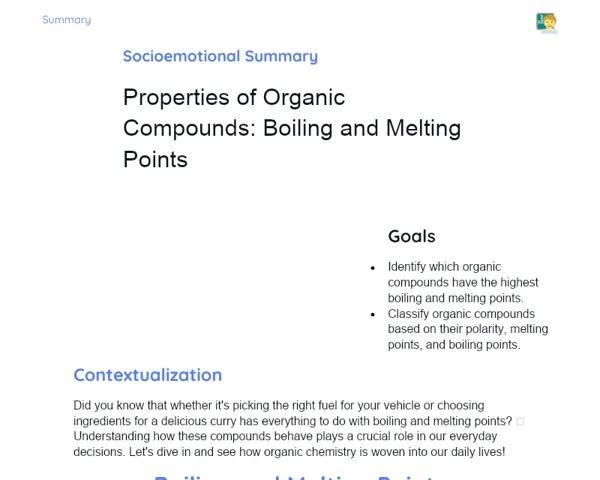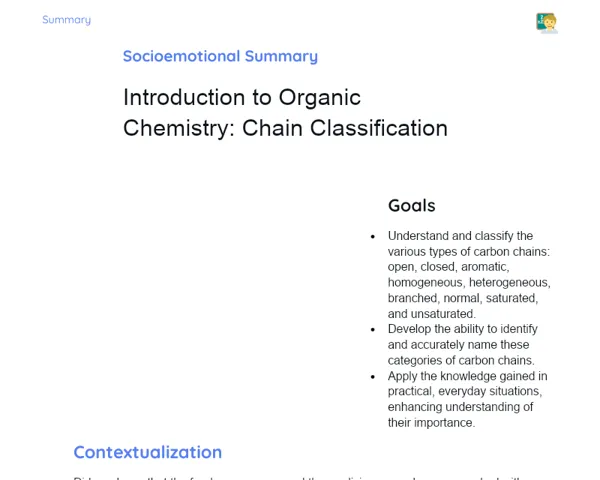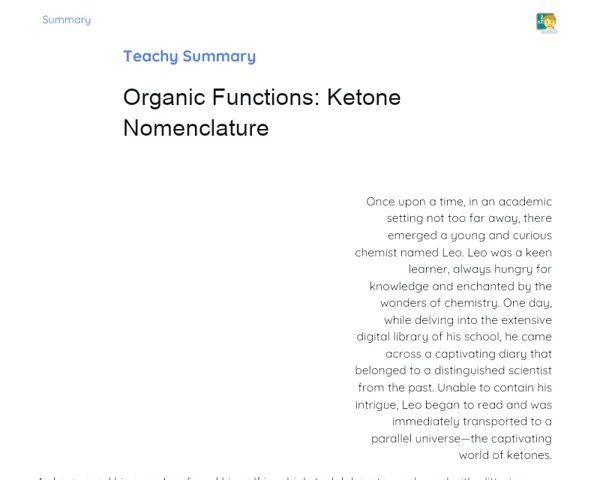Objectives
1. 🎯 Understand the chemical structure of ethers by identifying the oxygen atom linked to two alkyl or aryl groups.
2. 🎯 Describe the primary physical and chemical properties of ethers, including aspects like solubility, boiling point, and reactivity.
3. 🎯 Apply theoretical understanding to real-life examples in order to appreciate the role of ethers in both industrial and everyday settings.
Contextualization
Did you know that diethyl ether, the first ever used in medicine as an anaesthetic, marked a major breakthrough in general anaesthesia? This historical note not only underscores the importance of ethers in organic chemistry but also demonstrates their practical utility — from medicinal use to roles in the fragrance and solvent industries. This overview delves into both the chemical traits of ethers and the way these characteristics translate into everyday and industrial applications.
Important Topics
Chemical Structure of Ethers
Ethers are defined by an oxygen atom bonded to two alkyl or aryl groups, setting them apart from other organic compounds. This particular structure, often referred to as the ether bridge, imparts distinctive solubility and reactivity, making ethers especially significant in many chemical processes and industrial uses.
-
Ether Bridge: This is the connection where an oxygen atom attaches to two carbon atoms, allowing for a more even charge distribution compared to other compounds.
-
Group Variation: The alkyl or aryl groups bonded to oxygen can differ, which in turn influences properties such as solubility and boiling point.
-
Reactivity: Although the ether linkage is fairly stable, it can break under specific conditions. This trait is utilised in various organic syntheses and industrial applications.
Physical and Chemical Properties of Ethers
The physical attributes of ethers, like their boiling points and solubility, are directly affected by their molecular structure. For example, ethers with short carbon chains usually exhibit lower boiling points, whereas those with longer chains tend to be more soluble in organic solvents.
-
Boiling Point: It is influenced by the size of the carbon chain and any functional groups present that affect the molecule’s overall polarity.
-
Solubility: Ethers act as good solvents for a range of organic and inorganic compounds, which makes them valuable in several industrial processes.
-
Chemical Reactivity: While they are generally non-reactive, ethers can interact with strong acids or hydrogen halides, resulting in products that might include both aryl and alkyl ethers.
Industrial and Everyday Applications of Ethers
Thanks to their unique properties, ethers are used in a variety of applications, from serving as solvents in extraction procedures to being essential components in fragrances and perfumes. Moreover, they find roles in polymer synthesis and as intermediates in various chemical reactions.
-
Solvents: Both in laboratories and industries, ethers are extensively used for extraction processes and chemical reactions.
-
Fragrances and Perfumes: Owing to their ability to mix well with other compounds and low reactivity, ethers are incorporated into many fragrances and perfumes.
-
Polymer Synthesis: Ethers are crucial intermediates in polymer production, thereby playing a significant role in the plastics industry.
Key Terms
-
Ether: A group of organic compounds defined by an oxygen atom connected to two alkyl or aryl groups.
-
Ether Bridge: The bonding between the oxygen atom and the two adjacent carbon atoms that provides stability to the molecule.
-
Solvent: A substance which can dissolve other substances; ethers serve as common examples of organic solvents.
For Reflection
-
How does the molecular structure of ethers influence their physical and chemical properties? Can you provide practical examples?
-
Why are ethers often chosen as solvents over other organic compounds?
-
Discuss why ethers are important in the pharmaceutical industry and how their properties make them suited for specific applications.
Important Conclusions
-
🔬 We explored the distinctive structure of ethers, featuring an oxygen atom linked to two alkyl or aryl groups, highlighting their relevance in both organic chemistry and industry.
-
🌐 We examined how the physical and chemical properties of ethers, like solubility and boiling point, contribute to their effectiveness as solvents and as key components in daily and industrial products.
-
🚀 We understood the practical significance of ethers, noting their contributions from the pharmaceutical sector — for instance in anaesthesia — to manufacturing sectors like perfumes and plastics, thereby underlining their versatile nature.
To Exercise Knowledge
- Ether Synthesis Simulation: Use a chemistry kit to simulate the synthesis of a simple ether in a controlled setting or at home. Record the procedure and note the physical and chemical changes observed.
- Solubility Test: Experiment with different ethers by testing their solubility in water and other common solvents. Document your observations and attempt to explain these based on their molecular structures.
- Research Practical Applications: Select an ether and research its usage in fields such as medicine, cosmetics, or pharmaceuticals. Prepare a short report outlining your findings.
Challenge
🔍 Ether Detective Challenge: Drawing on your understanding of ether properties and applications, create a ‘profile’ for an unknown ether, detailing only its chemical and physical characteristics. Let your fellow students guess which ether it is based on your profile.
Study Tips
-
📚 Mind Maps: Create visual mind maps linking the chemical structure of ethers with their properties and applications. This method will help you better grasp the overall concept.
-
🔗 Relate to Daily Life: Try relating the properties and uses of ethers to everyday products or applications. This approach makes the learning process more relevant and engaging.
-
💬 Group Discussions: Organise group discussions with your peers to debate challenges or explore new applications related to ethers. Listening to various viewpoints can provide fresh insights.



